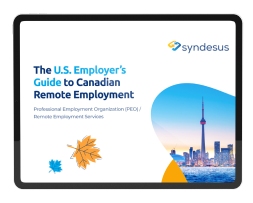US employers who hire foreign-born tech workers on H-1B visas are growing increasingly frustrated with how it’s getting harder and harder to actually get an H-1B visa. Because the labor demand is still there, however, many of them are taking a new approach: remotely hiring these skilled tech workers in Canada through Canada’s Global Talent Stream (GTS). This strategy is a great way to get them on board and have them close enough to the US and working in the same time zone.
GTS was launched in 2017 as a way to attract highly skilled workers, particularly tech workers. A part of Canada’s Global Skills Strategy, GTS empowers Canadian employers to speed up the process of hiring foreign tech workers to fill specialized jobs by fast-tracking work authorization, workers can have a work permit in approximately 10 days. Plus, the program is an excellent pathway to permanent immigration to Canada given that workers only need one year of Canadian work experience to qualify for permanent residency.
For US companies that already have an office in Canada, it isn’t difficult to leverage GTS to relocate much-needed tech talent – indeed many large US-based tech companies are already expanding into Canada.
But can employers who don’t have a Canadian entity still leverage GTS to hire much-needed tech workers?
The answer is a resounding yes. That’s where an Employer of Record (EOR) comes into play. An EOR provides all the legal and immigration requirements for remote hiring, payroll, HR, and many other services to enable companies to remotely hire workers in a country where they don’t have an office.
Employers who haven’t previously worked with an EOR often have questions about how this works and what to expect. This article covers three common questions that US-based companies ask about working with a Canadian EOR like Syndesus.
Is there a maximum number of employees I can hire in Canada through an EOR using Global Talent Stream?
Generally speaking, there is no maximum – you can hire as many foreign workers through an EOR as you need to.
As the official employer in Canada, however, the EOR is responsible for communicating with the Employment and Social Development Canada (ESDC) about how many GTS applicants they expect as required by the Canadian government.
The EOR also handles the Labor Market Benefits Plan as part of hiring via the GTS program, which is required to demonstrate the employer’s continued commitment to activities that positively impact the Canadian labor market.
Specifically, employers that utilize GTS must identify and track job creation, skills and training investments and other activities meant to benefit the Canadian economy. Indeed, one of the benefits of working with an EOR is that they take care of this for you.
Do EORs handle all the compliance, tax, HR, and immigration?
Yes! Since an Employer of Record acts as the legal employer in the host country, in this case in Canada, the EOR also handles all the technical aspects of employment, such as paying wages, managing immigration applications such as GTS applications, and taking on the legal responsibility of hiring, firing, and other HR matters.
The EOR handles HR, compliance, tax, and immigration, and makes the hiring process smooth, compliant, and stress-free.
Additionally, even while working with an EOR, employees are still able to hold stock options from the US employer and otherwise remain eligible for other benefits like healthcare, savings plans, and more.
At the end of the day, US employers who want to hire a remote tech worker in Canada via an EOR don’t need expertise in Canadian immigration or employment law nor do they need to hire attorneys, accountants, and other professionals. The EOR handles HR, compliance, tax, and immigration, and makes the hiring process smooth, compliant, and stress-free.
If I hire through an EOR, do I eventually need to open my own legal entity in Canada?
While you never need to open your own legal entity in Canada, you certainly can if you think there is a sufficient business case for it.
US employers often use a Canadian EOR to hire one or a few employees remotely in Canada, but they can also use an EOR to hire dozens or more.
Indeed it can be more cost-effective to hire multiple employees through an EOR in Canada since the Canadian entity is already handling many of the technical aspects of employment such as immigration and HR for the US employer’s tech workers.
If a company does decide to create its own entity eventually and effectively take its tech workers off of the Canadian EOR’s payroll and onto its own, a good EOR should help the US company figure out how to set up their Canadian legal entity, help the company with the transition away from the EOR, and provide ongoing support moving forward.
How Syndesus can help you hire tech workers remotely in Canada using the Global Talent Stream
Syndesus provides an EOR solution that helps US companies that don’t have an office in Canada leverage Canada’s tech talent and favorable immigration laws for tech workers, whether those companies are small US startups or large corporations.
Hiring workers remotely in Canada through Syndesus means that the immigration, payroll, HR, tax, and other administrative processes are taken care of for you while you focus on expanding or retaining your talented workforce.
Reach out to us to learn more about how we can help you hire and retain talent remotely in Canada, or if you’re a Canadian employer looking for US-educated tech talent, see how our Path to Canada services can help match you with top-tier talent that has been vetted and qualified for Global Talent Stream.






